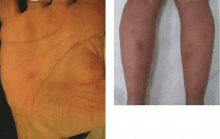Skin manifestations of diabetes
ABSTRACTDiabetes mellitus can be complicated by a variety of cutaneous manifestations. Good metabolic control may prevent some of these manifestations and may support cure. Unfortunately, most glucose-lowering drugs also have cutaneous side effects. It is important to be able to recognize these signs and symptoms and to either treat them appropriately or refer the patient to a dermatologist or diabetologist.
KEY POINTS
- Patients with type 2 diabetes more often develop skin infections, whereas those with type 1 more often have autoimmune-related lesions.
- Insulin signaling supports normal skin proliferation, differentiation, and maintenance, and a lack of insulin may lead to impaired wound healing, which may affect insulin resorption.
- Skin manifestations of diabetes may also serve as ports of entry for secondary infection.
- A candidal infection (moniliasis) can be an early sign of undiagnosed diabetes.
- Watch for dermal side effects of insulin injections and oral hypoglycemic drugs.
SKIN EFFECTS OF ORAL HYPOGLYCEMIC AGENTS
First-generation sulfonylureas
In 10% to 30% of patients using chlorpropamide, an alcohol flush is induced, consisting of redness and warmth, headache, tachycardia, and occasionally dyspnea, starting about 15 minutes after alcohol consumption. Usually, the symptoms disappear after an hour. This reaction pattern seems to be inherited in an autosomal-dominant pattern.6,37
Second-generation sulfonylureas
Second-generation sulfonylureas such as glipizide (Glucotrol) and glimepiride (Amaryl) have also been associated with cutaneous reactions. The most frequent reactions associated with glipizide are photosensitivity, rash, urticaria, and pruritus. These are reported less often with glimepiride. Deerochanawong46 reported patients with skin rash after the use of glimepiride. A case of lichenoid drug eruption was described by Noakes.47
Other oral hypoglycemic drugs
Metformin (Glucophage), a biguanide-derivative antihyperglycemic drug, is the first-choice oral drug in type 2 diabetic patients. Dermal side effects reported include psoriatiform drug eruption,48 erythema exsudativum multiforme,49 and leukocytoclastic vasculitis.50,51Litt’s Drug Eruption Manual gives the risk of photosensitivity reaction to metformin as 1% to 10%52 but cites no reference for this statement. Erythema, exanthema, pruritus, and urticaria have also been reported as side effects of metformin.52
Acarbose (Precose) is minimally absorbed from the gut: only about 1% of a dose reaches the bloodstream,53 and thus it seldom causes adverse effects. Kono et al54 reported a case of acarbose-induced generalized erythema multiforme confirmed by a challenge test. The drug-induced lymphocyte stimulation test and patch test for acarbose were negative. Ahr et al55 reported that acarbose labeled with carbon 14 was poorly absorbed when given orally, but that up to 35% of this formulation of acarbose was absorbed after degradation by digestive enzymes, intestinal microorganisms, or both. Because the drug-induced lymphocyte stimulation test and the patch test were negative in the patient described by Kono et al,54 it is possible that the degradation products of acarbose induced the allergic reaction after absorption. Poszepczynska-Guigné et al56 described the first case of acute generalized exanthematous pustulosis induced after administration of acarbose.
Thiazolidinediones. Edema has been reported as an adverse cutaneous effect of rosiglitazone (Avandia) and pioglitazone (Actos).52







